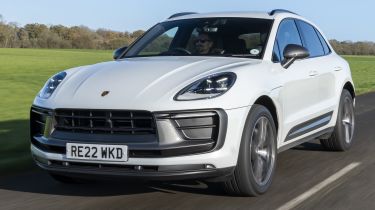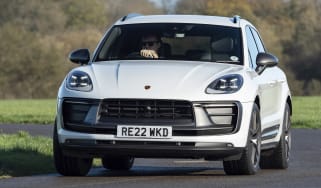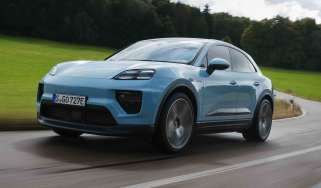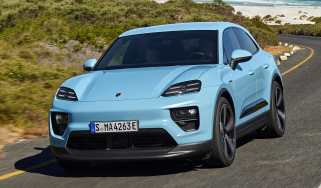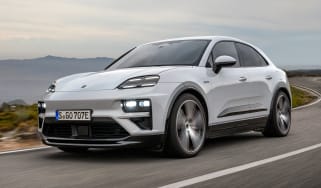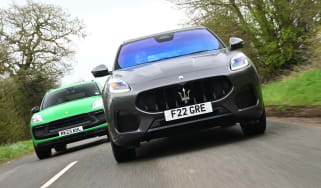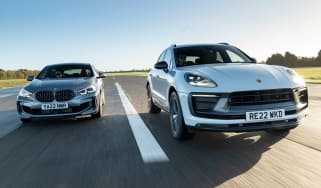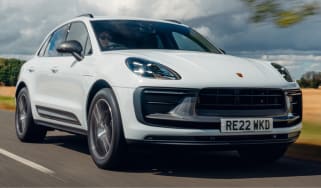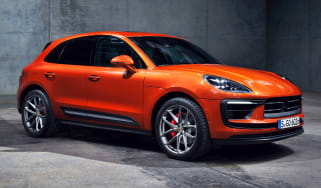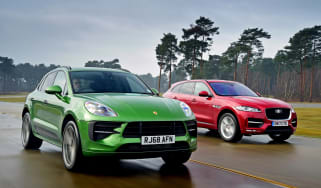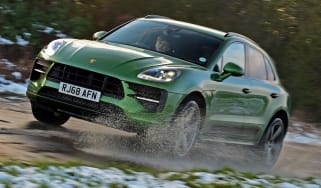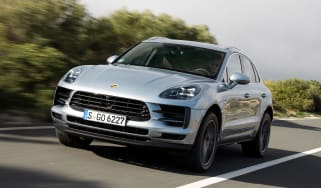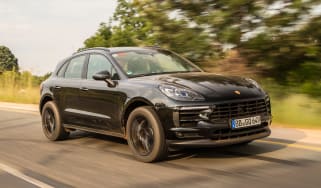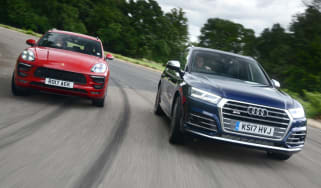Porsche Macan review: fun and practical sporty SUV
The Porsche Macan drives extremely well and has the right image, but it's thirsty and less comfortable than it should be

The Porsche Macan has been around for a long time, although, sadly, this version’s days are numbered. It’s a very popular premium mid-size SUV and there's a good reason for this. Beyond its desirable badge and stylish exterior, the Macan is one of the better SUVs to drive and if you can live with the relatively firm ride it’s still comfortable and practical enough to handle family car duties.
The Macan’s sporty focus continues in the petrol-only range of powertrains and the high running costs that come along with them. Yet the standard seven-speed PDK dual-clutch automatic gearbox means the Macan is a beautifully relaxed car to drive, and the fit and finish of the interior is simply flawless.
About the Porsche Macan
After the runaway success of Porsche’s first SUV, the Cayenne, it was clear the German sports car manufacturer couldn’t afford not to extend its presence in the SUV sector.
The Macan entered production in 2014, before an initial update in 2019 brought significant changes both inside and out. Another refresh in 2021 further extended the life span of Porsche’s mid-size SUV, because it’ll continue to be sold alongside a brand-new, electric-only Macan due to arrive in 2024.
The Macan is still a very desirable SUV that drives extremely well, which is a pretty remarkable feat for something that’s been in production for so long. But that’s not surprising considering it bears one of the most highly-regarded performance car badges of all time. There may still be some of Porsche’s more puritanical sports car fans who still roll their eyes at the mere idea of a Porsche SUV, but most of the rest of the world has got over that philosophical hurdle, as the sales figures attest.
Used - available now

2018 Porsche
Macan
69,610 milesAutomaticDiesel3.0L
Cash £22,997
2021 Porsche
Macan
32,140 milesAutomaticPetrol3.0L
Cash £37,895
2026 Porsche
Macan
23,136 milesAutomaticPetrol2.0L
Cash £48,990
2021 Porsche
Macan
44,176 milesAutomaticPetrol3.0L
Cash £42,636The Macan swims in a crowded pool. It’s up against the likes of the Jaguar F-Pace and Range Rover Velar, along with other German rivals such as the Audi Q5, BMW X3 and X4, and Mercedes GLC. Meanwhile, the Lexus NX features impressive on-board technology, and the Alfa Romeo Stelvio Quadrifoglio and Maserati Grecale offer buyers their own stylish take on what a premium SUV is all about.
The most recent round of updates in 2021 saw the flagship Macan Turbo axed, subtle power increases for the rest of the range and a few exterior details freshened up. Porsche’s baby SUV got a new front bumper and rear diffuser, standard Sport Design door mirrors, Porsche's LED Dynamic Light System, along with new wheel designs and fresh paint options. Inside the cabin, haptic touch surfaces replaced buttons, while the infotainment touchscreen grew substantially and now features the latest user interface.
The Macan lineup now consists of four models: the standard Macan, Macan T, Macan S and top-of-the-range Macan GTS. The base model and Macan T are powered by a 261bhp version of the same 2.0-litre turbocharged four-cylinder petrol engine, while the Macan S uses Porsche’s in-house 2.9-litre hot-V (which denotes that the two turbochargers live within the ‘V’ of the engine) V6 petrol unit packing 375bhp. The top-spec GTS model uses the same V6 but produces 434bhp – 69bhp less than the BMW X3 M and X4 M. Both engines are connected to a seven-speed PDK auto gearbox and four-wheel drive as standard.
Engines, performance and drive
It’s worth remembering that like Porsche’s other SUV, the Cayenne, the Macan isn’t a bespoke model like its sports cars. Instead, the Macan actually sits on a platform borrowed from the previous-generation Audi Q5. Yet despite this less-than-idea start point, Porsche did a comprehensive job of re-engineering the elements it had to work with, giving the Macan a distinctive feel peppered with plenty of Porsche-like traits in its steering, handling and chassis balance.
All of its basic dimensions and suspension components are bespoke to the Porsche, with a wider track, longer wheelbase and lower roof height all giving the Macan an almost coupe-like stance on the road. As well as looking different, it also helps the Macan feel exceptionally stable at speed, underpinned by impressive body control and very high grip levels on account of its wide tyres.
It’s equally as impressive at slower speeds in and around town, where you notice the smoothness of the dual-clutch automatic gearbox. It doesn’t fuss or lurch as you move away from a standstill which means it’s more usable and relaxing to drive than some rivals.
Conventional steel coil springs and passive dampers are standard on the base Macan, with T and S models upgrading to three-way PASM adjustable dampers. Like many Porsches, the Macan’s ride quality is always firm, but rarely deteriorates into being brittle or uncomfortable. Its main priority is to keep the body under complete control, something it does with great success despite weighing between 1,845kg and 1,930kg, depending on the engine. Models fitted on PASM dampers widen the suspension’s bandwidth without going too far in either direction.
Top-spec GTS models swap this arrangement out for an air-spring setup, again fitted with corresponding adjustable dampers. The GTS has the most dynamically focused setup, sitting 15mm lower than cars on steel springs, dropping another 10mm when you press the Sport button. It’ll also rise by 40mm when you select the off-road mode. Unfortunately, despite the extra variability, the air-springs themselves take away a certain level of connection from the road, and in combination with the GTS’s standard 21-inch wheels can be a little too stiff in Sports mode.
Of course, the different suspension systems are just the tip of the iceberg when it comes to the Macan’s chassis, with high-spec inclusions like a torque-vectoring rear differential (PTV Plus), Power Steering Plus and even carbon ceramic brakes (PCCB) on the options list.
Yet it’s the fundamentals that the Macan gets right. The heavily weighted and accurate steering needs the smallest of inputs before the car instantly turns in with the sort of precision and poise you just don’t expect in a jacked-up car this size. But, it’s worth mentioning that the Macan isn’t as refined as many premium rivals, especially on larger wheels.
There are huge reserves of grip, and combined with standard four-wheel drive, the Macan unlocks a level of confidence that few rivals can match. The chassis needs a certain level of performance to unlock its potential – a level of performance that the four-cylinder Macans just don’t have – with the capable GTS dynamically closer to a high-end hot hatchback, than a high-riding SUV. Its explosive V6 engine is a delight to exploit as you accelerate out of corners, making a full-blooded noise as it revs right up to the red line.
0-62mph acceleration and top speed
The Macan’s engine range is a story of two halves, split between in-line four-cylinders and a V6. Putting it simply, the four-cylinder engine found in the latest Macan and Macan T just aren’t powerful enough to overcome the car’s weight or offer a dynamic driving experience to challenge the car’s outstanding grip levels. The engine itself is an impressive unit in other applications, namely the Golf GTI and Audi S3, but when trying to fight around 400kg of extra mass, 261bhp just isn’t enough. Some clever launch control antics, all-wheel drive and a sharp-shifting seven-speed dual-clutch PDK transmission do make for an impressive-sounding 0-62mph acceleration time of 6.2 seconds, but on the road it does not translate, often hunting through gears trying to find power that’s just not really there.
The Macan S and GTS are a different case. Rather than a VW-sourced four-cylinder, the V6 is a through-and-through Porsche unit, co-developed with Audi for use in some of its RS models. In the Macan S, the twin-turbocharged 2.9-litre V6 petrol engine produces a much more substantial 375bhp, and thanks to a clever hot-V turbocharger layout, is both more responsive and surprisingly efficient, making it only 2mpg thirstier than the four-cylinder Macan T. This is reflected in its 0-62mph time of 4.8 seconds (with the Sport Chrono package), but felt even more acutely on the road as the same PDK transmission doesn’t have to work nearly as hard to deliver considerably more performance.
Sitting at the top-of-the-range is the Macan GTS, packing an even more potent 434bhp tune, essentially replacing the now-defunct Turbo model. It manages the 0-62mph sprint in 4.3 seconds – a hugely impressive time – but if you’re under the impression that it will keep up with rivals like the Alfa Romeo Stelvio Quadrifoglio or BMW X3 M you might be disappointed because both of those admittedly more expensive rivals deliver considerably more performance from their own turbocharged, six-cylinder engines.
Don’t bother looking for any hybrid or diesel options, though, as the Macan is strictly petrol-powered only.
MPG, CO2 and running costs
Prices for the Macan range start from around £56,000, so all cars face the higher road tax rate for the first five years of ownership.
The Macan is thirsty compared with the latest range of fuel-sipping premium SUVs from Mercedes or BMW. Even the four-cylinder in the base model and Macan T will only return 28mpg at best while emitting up to 243g/km of CO2 due to its high weight figure, wide tyres, and an ageing platform
The V6-powered Macan S and GTS aren’t much better in terms of fuel consumption, capable of 25.4mpg and 25mpg, respectively, and emitting roughly 250g/km of CO2 at the same time. However, thanks to the V6’s extra grunt, you’ll find yourself working it much less, making their mpg figures more achievable and, at times, preferable to the four-cylinders. The extra performance from the engine also makes it a figure that’s easier to justify.
There isn’t a company car-friendly plug-in hybrid version with an electric range and low Benefit-in-Kind (BiK) rates. However, there will be an all-electric version coming soon that’ll have some seriously low BiK rates – just in time for the rates to go up in 2025.
Insurance groups
Each model is performance-oriented and with prices escalating well over £50,000, you're destined to be paying a small fortune out on insurance as well as fuel. The standard model is in group 41, rising to 44 for the T, 45 for the S, topping out at group 47 for the GTS.
Petrol versions of the 2.0 Turbo 280 Alfa Romeo Stelvio that offer similar performance to the Macan T should be cheaper to insure due to being in group 36. Meanwhile, the more powerful BMW X3 M just undercuts the Macan GTS by being in group 45.
Check if your car needs an MoT and view its complete history with our MoT History Checker...
Depreciation
The premium SUV sector is home to some of the strongest residual values anywhere in the new car market, and the Porsche Macan is one of the strongest models for residual values in the class. When it was launched, extremely strong demand meant early buyers could sell their cars after 12 months of use at the same price they paid for the car in the first place.
Those days are long gone, though. The strongest performing Macan is the standard version according to our experts, and should hold 59 per cent of its resale value after three years and 36,000 miles. The worst version is the S, although a 53 per cent result is still very good compared with rivals.
A Range Rover Velar holds its value similarly well over the same period, while the Audi Q5 and BMW X3 do significantly worse.
To get an accurate valuation on a specific model check out our free car valuation tool...
Interior, design and technology
When Porsche set out to design a sporty mid-size SUV in the first half of the last decade, you could say it hit the nail on the head with the Macan. Being a little smaller and less dependent on ultimate practicality, Porsche’s designers gave the Macan a sleek silhouette that combined with plenty of familiar design cues and large wheels to create a look that’s just as appealing today as it was in 2014.
There has been a series of updates since the Macan was launched, rather than just one mid-cycle nip and tuck, the last coming in 2021. This introduced slightly redesigned front and rear bumpers, some new colours and wheel designs.
The Macan’s interior is also excellent. It’s decently spacious considering the external footprint, plus the build and material quality is top notch – it feels just as well built as a Porsche Cayenne that can cost over twice as much. The driving position has impressive adjustment, too, giving you the option of sitting high up and over the dash, or more snugly within its confines. The seats are also brilliantly comfortable – be that the standard or sports seats. The small, round and thinly-padded steering wheel also feels great, and comes with (where fitted) a button for its heating function hidden away in the opening of the lower spoke.
However, there’s no doubt that the interior design is starting to age, and despite some substantial tech updates it can’t help to feel a little behind the curve. Nothing reveals this more than the dial pack – we’re not one to lament analogue dials, but the small information screen that’s integrated into the right-hand roundell looks old, and dates the whole cabin.
The Macan's standard kit list includes eight-way adjustable electric seats, automatic air-conditioning, front and rear parking sensors, cruise control with a speed limiter function, lane departure warning, electrically adjustable heated door mirrors, rain-sensing wipers, LED headlights and daytime running lights, plus three-zone climate control and an automatic tailgate.
The Porsche Macan comes as standard with 19-inch alloy wheels, while the S model has 20-inch rims, but there are a number of optional 19, 20 and 21-inch wheels to choose from. These are available in a range of finishes, including a match to the car’s body colour. However, it’s worth remembering that these optional wheels are pretty pricey.
Sat-nav, stereo and infotainment
As part of the updates in 2019 Porsche completely overhauled the Macan’s infotainment system, borrowing the sleek 12.3-inch touchscreen unit found in the Cayenne and Panamera. The display itself is sharp and responsive, and while the interface isn’t as fancy or customisable as rivals from BMW or Mercedes, it is relatively easy to use and suits the pared-back nature of the rest of the interior. More recently, the 2021 update then replaced the button-festooned centre console in favour of the sleeker haptic feedback panel, further modernising the interior.
Like all Porsche models, we’d suggest it’s well worth upgrading to the optional Bose sound system at a minimum, as Porsche’s basic stereos are average at best, and can even struggle to compete with the tyre roar on rough and noisy roads. Wireless Apple CarPlay is standard on the Macan, but Android Auto is nowhere to be found.
Practicality, comfort and boot space
By featuring four-wheel drive as standard, you'll be well-equipped if there's a sudden cold snap or if you need to do a bit of light off-roading. We’ve tackled some slippery inclines and descents in the Macan, something only helped by pressing the 'off-road’ button. This adjusts the throttle response and relevant torque splits to help with off-road driving.
Those cars fitted with air suspension (standard on the GTS) rise by 40mm for off-road work, taking maximum ground clearance to 230mm. There's a separate button for hill descent control, too, which will take charge of the brakes for you on a slippery descent, keeping the speed between 3mph and 18mph and you in control of the car.
Each and every Macan comes as standard with an electronically opening tailgate, as well as front and rear parking sensors to help avoid any nasty scrapes.
Buyers with young children will appreciate the ISOFIX mounts that are easily accessible behind plastic covers, while the rear bench seat splits in a 40:20:40 configuration which can be useful when ferrying around a combination of passengers and cargo.
Dimensions and Size
The Macan measures 4,726mm in length, 1,922mm in width and stands 1,621mm tall, which means it takes up a little more space on the road than an Audi Q5, although the Audi is slightly taller.
Leg room, head room & passenger space
There's not as much headroom in the Macan compared to the more traditionally styled SUVs it competes with, but you'll have no trouble fitting five adults into the cabin. There's a fair amount of knee room and leg room in the rear is decent enough.
Boot space
The Macan's boot is large enough to hold 488 litres of luggage while you've got the rear seats up, but you can fold them down to free 1,503 litres of space. That means that despite its relatively sporty shape, the Macan is a genuinely spacious car, with room for a family and their luggage. You do have the contend with a fairly chunky load lip when loading up the boot, but there is also a sizeable storage area under the floor.
Towing
If you're planning on towing, we’d suggest ensuring your model has a reversing camera fitted to help hitch the trailer, while the torquey engines offer lots of pulling power to make light work of loads. Peak braked towing capacity for the four-cylinder models is rated at 2000kg, or 750kg on an unbraked trailer, and the V6-powered S and GTS share the same unbraked figure with a slightly higher 2400kg braked figure.
Reliability and safety
The Macan is loosely based on the Audi Q5, which is a relatively reliable 4x4. With Porsche’s solid dependability, the Macan shouldn’t give you many ownership headaches. If it does, there is a large network of dealers in the UK so they should be able to sort out any issues – at a price of course.
Customers certainly seem to be impressed with the German manufacturer – Porsche came top in our best car manufacturer rankings in 2021, 2022 and 2023, which are based on the results of our annual Driver Power owner satisfaction survey. Porsche owners ranked their cars in first place in the survey for driving characteristics, as well as for design and peerless build quality.
The Macan was a five-star performer according to Euro NCAP when it was tested back in 2014. However, the criteria for crash testing has become much more stringent since then, and so the score for the Macan has expired. That’s not to say the Macan wouldn’t still protect you in a collision, it's just that there are newer models around that might do so even better. The Macan still comes as standard with ESP and front collision warning sensors, as well as a lane departure warning. There’s also a rear side airbag option to further improve safety for those in the back.
Warranty
As with all Porsches, the Macan comes as standard with a three-year/unlimited mileage warranty. That’s very similar to what BMW offers for its models.
Servicing
Every Macan has a service schedule of two years or 20,000 miles, whichever comes first. There are also service plans available should you want to spread the costs.
Porsche’s 'My Porsche' digital system can configure and manage your servicing appointments and stay informed about any relevant information. It also provides service reminders, safety updates and even notifications concerning Porsche events.

